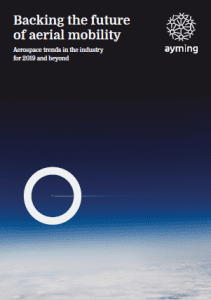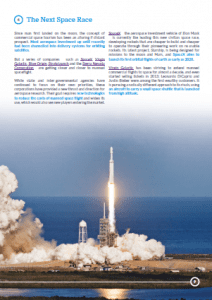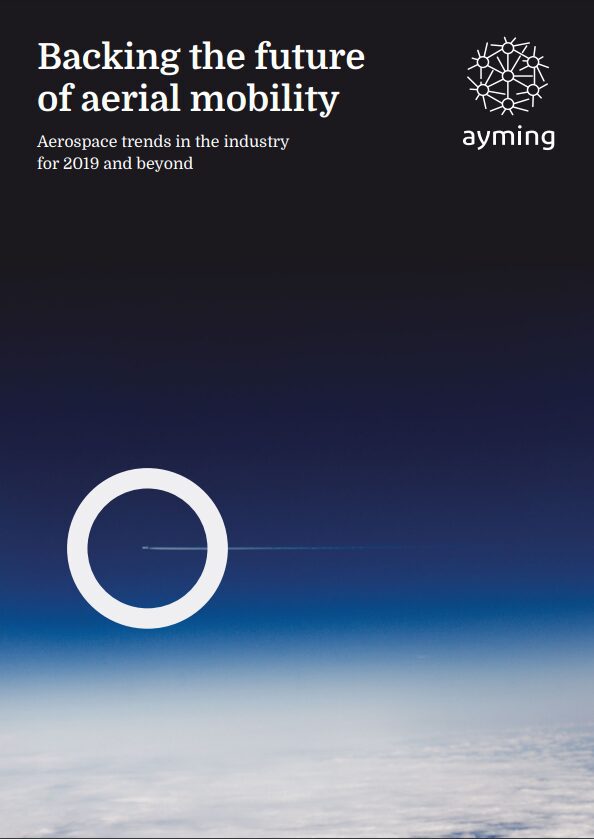
Table of contents
Executive Summary
For decades, ‘flying cars’ in futuristic cityscapes have been a staple of science fiction. However many of the most outlandish ideas of the genre have now become reality. In Back to the Future Part II, when Marty McFly and Doc travel to the year 2015, they experience a world with what seemed like fantastic inventions 30 years ago when the film launched.
From drones reporting the news to wearable technology, much of that fantasy is today’s reality.
However, one of the most memorable pieces of technology from the film, still hasn’t arrived: Air Taxis. Yet, in the year 2019, that vision remains a preoccupation for many aviation engineers and investors.
Among the many fascinating areas of aerospace research and development, the other powerful trends that we see gathering momentum through 2019 involve some of the key technologies required to support short-range air commuting and the proliferation of drones, as well as the technologies required to police them.
We are also witnessing a new kind of space race – not between nations – but a private competition to open up space travel to the masses, and inspired by the free market’s entrepreneurial galacticos.
Having buckled our seat belts, let’s take a swift tour of the four main aerospace trends that are expected to take flight in 2019:
The four trends
- eVTOL aircraft
- Unmanned aircraft systems traffic management (UTM)
- Counter-UAV technology
- The next space race
eVTOL aircraft
Urban Aerial Mobility (UAM) – cross-city or sub-regional flights across relatively short distances – is not a new concept. However, the increasingly congested roads of our megacities only give the efforts to achieve it greater impetus.
Aerospace engineers and mobility moguls see this potential for ‘air taxis’ to over-fly traffic and reduce congestion, and to provide easier access and quicker response times in emergencies for air ambulances or high-rise fire and rescue teams1. However, aircraft types as we know them are not suitable for this role;
- Aeroplanes need large runways and other infrastructure that cannot be easily accommodated within major cities. They also need an unobstructed flight path which limits the construction of high-rise buildings in the vicinity and makes city planning harder.
- Helicopters can and do act as air taxis but are far more expensive to operate than aeroplanes on a mass scale. Even small 2-seater helicopters need approximately
30 hours of maintenance for every 100 hours of flight, due to the complexity of the mechanical systems that create the rotary motion of the blades. They also generate a lot of noise pollution. In any case, the potential hazard from multiple helicopters with unguarded rotary blades prevents high numbers of these flying in proximity to buildings or each other.
To overcome these challenges, innovators around the world are instead focusing on electric vertical take-off and landing (eVTOL) aircraft, which are cleaner, quieter and safer than helicopters. The mechanical complexity of an electric drivetrain is much simpler than that of a helicopter and the resulting maintenance and operation costs are significantly cheaper. These aircrafts can be used to transport passengers at much higher volumes than existing helicopters and globally, there are now more than 100 companies developing different configurations to compete in this new mobility market.
Big players in the eVTOL space include Bell Nexus, Aurora Flight Sciences, Airbus CityBus and its Silicon Valley subsidiary A3 Vahana. It’s remarkable however that most progress appears to be coming from smaller start-ups that are challenging industry incumbents for dominance in this new age of aviation. German start-ups Lilium Aviation and Volocopter have raised €100m and €30m respectively and have already begun flight testing of full-scale aircraft, while Joby Aviation has raised $130m and is racing ahead of the aerospace giants.
ShapeThe upwardly mobile include another familiar force; Uber has created its own initiative, Uber Elevate, which aspires to run an air taxi service ferrying 4-5 passengers at a time between the suburbs and city centres. Uber’s ambitious timetable is for roll-out – most likely in Dallas and Los Angeles initially – by 20232, but questions remain over the maturity of technologies for commercial operation.
Looking at other applications, thrill-seekers are no longer limited to jet skis and quadbikes. Smaller eVTOL aircraft – such as the Kittyhawk Aero Flyer, Opener Blackfly, Lift HEXA and Hoversurf S3 Hoverbike – due to their size, can already fly in the US without any regulation. While not suited for the role of air taxis, they are useful technological test beds, as well as recreational vehicles for the wealthy and are becomingly increasingly available for experience days.
Looking to the long term, a series of studies by respected consultants – including Roland Berger, McKinsey, Porsche Consulting and Deloitte – believe that eVTOLs could become as commonplace as the car.
However, there are still some major aerial roadblocks. Even when the technology is proven, regulators must come to terms with its usage and as a result, and it may not enter the mainstream for at least another 5 to 10 years, regardless of technology maturity.
Unmanned aircraft system Traffic Management (UTM)
Some technologies have a way of promoting, or provoking, further waves of innovation. Mass eVTOL services will make huge demands on air traffic control. But first, our systems for managing airspace must contend with the proliferation of UAVs (unmanned aerial vehicles) or “drones”.
The number of drones in the US is projected to more than double from 1.1 million in 2017 to 2.4 million in 20223. This increase in autonomous aircraft – perhaps, to be followed by pilot-less air taxis – gave rise to the concept of Unmanned aircraft system Traffic Management (UTM).
This concept offers a solution for tracking and mapping all of the UAVs within a given area, with the aim of avoiding collisions between drones and with larger, manned aircraft. Drones now are generally limited to operations within the operator’s visual line of sight so as to manage this risk but UTM systems would allow drones to fly beyond this limited range and operate safely within a crowded airspace.
Many companies are working on the software needed to ensure high levels of safety within congested airspace but commercial UAV operators are already implementing this technology to meet safety requirements for protecting manned aircraft and other drone users.
Substantial work is being done in the UK where Manchester Airport last year hosted ‘Operation Zenith’4. The UK National Air Traffic Service (NATS) – in partnership with aviation technology specialist Altitude Angel – set out to prove that drones could be safely flown alongside large commercial airliners, performing inspections and other airfield tasks.
Other companies are also investing in and refining the technology – from NASA to Uber, as well as a host of dedicated UTM providers such as Airmap and Unifly.
Like them, the European Commission wants to “support safe, efficient and secure access to airspace for large number of drones” and to promote competition and job creation in this new sector of the economy. As a result, its “U-Space” Initiative5 sets out to implement four services to support a regulatory framework for drones, covering:
- e-registration, e-identification and geo-fencing
- Drone operations management, including flight planning, flight approval, tracking, and interfacing with conventional air traffic control
- More complex operations in dense areas such as assistance for conflict detection and automated detect- and-avoid functionalities
- Very high levels of automation, connectivity and digitalisation for both the drone and the U-space system
These services typically rely on aircraft communicating with each other to ensure that their position is known to others but with further innovation, UAVs may gain autonomous decision-making skills including on-board ‘sense and avoid’ technology with the ability to avoid collisions with unexpected objects as well. For example, UAVs could be notified when a police helicopter is entering the vicinity so they remove themselves to a safe position to await further instructions.
As the number of UAVs in our skies increase, so does the need for a powerful centralised system and this will most likely require artificial intelligence to make complex decisions and keep airspace safe. The incentives for developers of UTM applications that facilitate the widening use of drones are considerable.
Counter-UAV technology
It is not just the proliferation of UAVs that raises concerns for safety. The well-publicised use of military drones – for surveillance and attacks – highlights the risks that terrorists might adapt commercial UAVs to threaten civilian targets.
A few weeks after Manchester’s Operation Zenith, the threat posed by maverick or malevolent drone operators was vividly demonstrated first at Gatwick Airport, in December 2018, and then Heathrow Airport in January 2019. Both airports were forced to shut down, disrupting the travel plans of thousands and costing airlines millions in compensation payments amid the chaos6.
Drones have already been modified in conflict zones such as Syria and Iraq to explode, collect intelligence or record insurgency attacks for propaganda purposes and could pose a more serious threat in the immediate future.
The UK government was already committed to requiring owners to register their drones from November 2019 and systems are being developed to identify drones while they are in the air. However such a regime is unlikely to prevent malicious activities.
Police and defence forces have limited options for tackling hostile UAVs; Using live ammunition would risk injuring bystanders with bullets or falling debris but there are a host of alternative technologies that could be used in the coming years.
These include high-energy microwave pulses and lasers, hand-held and drone-mounted net guns, and – a more traditional ally for hunting a modern foe – falcons.
Radar jamming – to block communications between the operator and their drones – may be the most promising solution, for now but when UAVs have the capability to make autonomous decisions, they will not need to communicate with base, and radar jamming may become ineffective.
The Israeli Drone Dome technology is a strong contender in this space, with the ability to deny operators the ability to control their UAVs within a six-mile radius but this system is as yet undelivered to the UK and other existing systems may simply be a short-term fix until it can be deployed.
Several small start-up companies are working on defence systems that protect against drones such as Skydroner which is said to detect and disable unwanted drones from over 1,000 metres away, while Dedrone was used at both the Rio Olympics and the final 2016 US Presidential debate in Las Vegas7.
These are particularly important as standard prevention methods such as geo-fencing enforced by drone manufacturers, can be overcome fairly easily. The international exposure of the vulnerability of the UK’s two largest airports can only focus even greater attention on the need to develop systems for policing and preventing drone incursions.
The range of potential targets – from prisons and nuclear facilities to parliamentary buildings and corporate headquarters – highlights the scale both of the challenge and the potential market for effective solutions.
The next space race
Since man first landed on the moon, the concept of commercial space tourism has been an alluring if distant prospect. Most aerospace investment up until recently had been channelled into delivery systems for orbiting satellites.
But a series of companies – such as SpaceX, Virgin Galactic, Blue Origin, Stratolaunch and the Sierra Nevada Corporation – are getting closer and closer to manned spaceflight.
While state and inter-governmental agencies have continued to focus on their own priorities, these corporations have provided a new thrust and direction for aerospace research. Their goal requires new technologies to reduce the costs of manned space flight and widen its use, which would also see new players entering the market.
SpaceX – the aerospace investment vehicle of Elon Musk – is currently the leading this new civilian space race, developing rockets that are cheaper to build and cheaper to operate through their pioneering work on re-usable rockets. Its latest project, Starship, is being designed for missions to the moon and Mars, and SpaceX aims to launch its first orbital flights of earth as early as 2020.
Virgin Galactic has been striving to extend manned commercial flights to space for almost a decade, and even started selling tickets in 2013; Leonardo DiCaprio and Justin Bieber were among the first wealthy customers. It is pursuing a radically different approach to its rivals, using an aircraft to carry a small space shuttle that is launched from high altitude.
Experiencing severe setbacks after a fatal crash during a test flight in 2014, Virgin Galactic has now built a new SpaceShipTwo and in February 2019, has been edging ever closer to the final frontier, recently reaching altitudes of 90km (most space agencies define space as being 100km above sea level). This was the first US commercial human flight to reach the edge of space since America’s shuttle programme ended in 20118.
Meanwhile, Amazon founder Jess Bezos’s Blue Origin is another company planning to start taking passengers into space as early as next year. Its grander aim is to “preserve Earth” by re-using its rockets to explore space and tap into its “unlimited resources and energy”9.
Making rockets re-usable is crucial to reducing costs and the space tourism business model but also reduces the amount of waste being left floating in space – a crucial problem for future generations of spacefaring passengers.
Aerospace companies are focusing on maximising the re-usability of spacecraft, thereby reducing the cost of manufacturing fleets, but researchers are also developing new types of hybrid rocket engines with motors that use different fuel types – solid, liquid or gas – in two phases. The huge technical challenge is to deliver greater efficiency without compromising the safety of the craft and those on board.
Even without major technological breakthroughs, the incremental progress being made suggests the number of sub-orbital flights is set to increase and could even open an alternative intercontinental travel market for the civilian space pioneers and high-net-worth individuals.
As the craft leave the earth’s atmosphere in sub-orbital flight, they can travel much faster than commercial airlines. According to the real estate consulting company, Knight- Frank, the super-rich are lining up in the hope that in the near future, flights from Sydney to London could take around 2.5 hours10.
As space tourism takes off, low-earth orbit could also be a staging post for high-end vacations. Bigelow Aerospace is one of several companies working up ideas. Its offshoot, Bigelow Space Operations, is currently testing inflatable habitats on the international space station and plans to launch two low-earth orbit inflatable habitats in 2021. Each will be able to house six people within 330 cubic metres of expandable space11 but Bigelow sees these as stepping stones to larger space stations and even space hotels.
Some final thoughts
Aerospace technologies are branching out in new directions and generating new waves of innovation and investment.
The rise of the drone and its spread into applications across industry is unstoppable but this phenomenon, in turn, is spurring research in the technologies needed to facilitate and control the use of unmanned aerial vehicles.
The other most momentous aerospace trends are paving the way for a revolution in aerial transportation of people and goods – around cities and in outer space. For now, sub-orbital space travel and tourism seem closer to becoming reality than sub-regional ‘air taxi’ trips closer to home below, but the research efforts invested in the technologies on which these developments depend will certainly intensify through 2019.
1https://medium.com/aviaryproject/flying-cars-ac2c323ba7c0
3https://www.iii.org/fact-statistic/facts-statistics-aviation-and-drones
4https://www.altitudeangel.com/blog/guardianutm-os-successfully-powered-operation-zenith-the-uk-s-most-comprehensive-drone-trial/
5 https://www.sesarju.eu/U-space
6https://www.bbc.co.uk/news/business-46957185?intlink_from_url=https://www.bbc.co.uk/news/topics/cnx1xjxwp51t/gatwick-drone-shutdown&link_location=live-reporting-story
8https://www.theguardian.com/science/2018/dec/13/virgin-galactic-spaceshiptwo-launch-california-edge-of-space
9https://www.blueorigin.com/our-mission
10https://www.smithsonianmag.com/smart-news/sub-orbital-travel-its-small-small-world-180950014/
11https://futurism.com/space-hotels-open-2021







